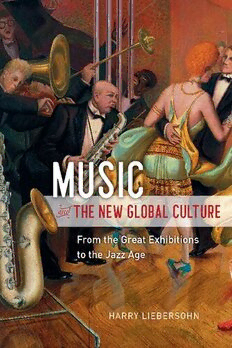
Music and the New Global Culture: From the Great Exhibitions to the Jazz Age PDF
Preview Music and the New Global Culture: From the Great Exhibitions to the Jazz Age
Music and the New Global Culture BIG ISSUES IN MUSIC A project of the Chicago Studies in Ethnomusicology Series Edited by Philip V. Bohlman and Ronald M. Radano ALSO IN THIS SERIES Everyday Creativity: Singing Goddesses in the Himalayan Foothills by Kirin Narayan Music and Capitalism: A History of the Present by Timothy D. Taylor M U S I C and THE NEW GLOBAL CULTURE From the Great Exhibitions to the Jazz Age HARRY LIEBERSOHN The University of Chicago Press Chicago and London Publication of this book has been supported by the Joseph Kerman Endowment of the American Musicological Society, funded in part by the National Endowment for the Humanities and the Andrew W. Mellon Foundation. The University of Chicago Press, Chicago 60637 The University of Chicago Press, Ltd., London © 2019 by The University of Chicago All rights reserved. No part of this book may be used or reproduced in any man- ner whatsoever without written permission, except in the case of brief quotations in critical articles and reviews. For more information, contact the University of Chicago Press, 1427 E. 60th St., Chicago, IL 60637. Published 2019 Printed in the United States of America 28 27 26 25 24 23 22 21 20 19 1 2 3 4 5 ISBN- 13: 978- 0- 226- 62126- 5 (cloth) ISBN- 13: 978- 0- 226- 64927- 6 (paper) ISBN- 13: 978- 0- 226- 64930- 6 (e- book) DOI: https:// doi .org/ 10 .7208/ chicago/ 9780226649306 .001 .0001 Library of Congress Cataloging-in-Publication Data Names: Liebersohn, Harry, author. Title: Music and the new global culture : from the great exhibitions to the jazz age / Harry Liebersohn. Other titles: Big issues in music. Description: Chicago ; London : The University of Chicago Press, 2019. | Series: Big issues in music Identifi ers: LCCN 2019008605 | ISBN 9780226621265 (cloth : alk. paper) | ISBN 9780226649276 (pbk. : alk. paper) | ISBN 9780226649306 (ebook) Subjects: LCSH: Music and globalization—History. | World music—History and criticism. | Ethnomusicology—History. | Globalization—History. | Sound recording industry—History. Classifi cation: LCC ML3916 .L54 2019 | DDC 780.9—dc23 LC record available at https://lccn.loc.gov/2019008605 This paper meets the requirements of ANSI/NISO Z39.48- 1992 (Permanence of Paper). For Dorothee CONTENTS Introduction 1 PART I CRAFT 1 A German Connoisseur in Cosmopolitan England 29 2 An English Craftsman Discovers World Music 47 PART II SCIENCE 3 Sound in Historical Time 75 4 Scales around the World 91 5 Is It Noise, or Is It Music? 123 6 Music’s Global Archive 151 PART III COMMERCE 7 Phonographs around the World 177 8 Americans Abroad: Innocents and Transnationals 195 9 A Global Empire of Sound 221 10 Commerce versus Culture 237 Conclusion 249 Acknowledgments 265 Notes 271 Further Reading 327 Index 331 Introduction Anyone who has heard of Ravi Shankar will probably associate his name with some of the most marvelous moments of the 1960s. There is the image of him at Woodstock: the world- famous sitar player amid the galaxy of rock stars, becoming a kind of rock star himself in the giddy days of summer ’69. Fans around the world heard the sounds of his instrument, the sitar, in the albums of the Beatles, fi rst toyed with as an exotic prop, then played with greater seriousness by George Harrison after the group spent time with Shankar in India. At the time, the master reacted with private impatience to the adulation of his countercultural admirers. Yet in later years he could take a wider view. Some of the people who on fi rst hearing Indian music treated it so casually, he wrote in his autobiography, went on to develop a serious relationship with it. In the end, he had made the right decision to take up the role of Indian music’s emissary to the West.1 Shankar’s experiences in the 1960s were but one chapter in a lifetime of cultural encounters. They began in Paris in the 1930s, when he was still a boy. A fi lm clip shows him with the dance troupe of his older brother, Uday Shankar.2 Uday brought Indian dance and music to European and American audiences. Ravi not only played and danced in his brother’s ensemble but also got a French education, reading novels, cultivating himself widely, and 1
